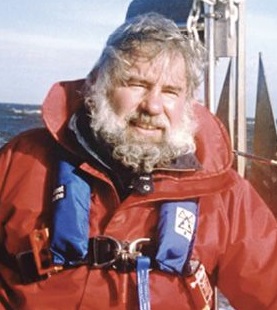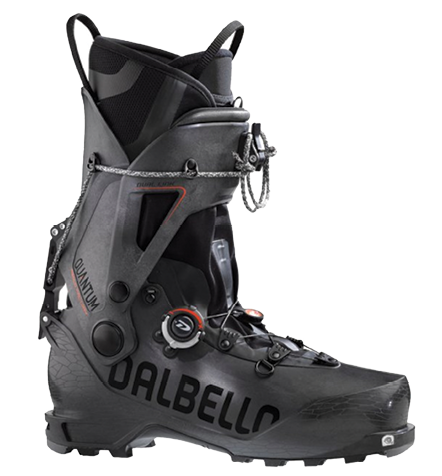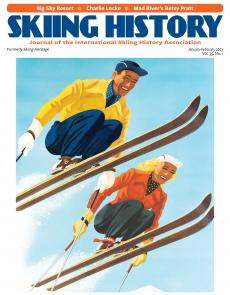SKIING HISTORY
Editor Seth Masia
Managing Editor Greg Ditrinco
Consulting Editor Cindy Hirschfeld
Art Director Edna Baker
Editorial Board
Seth Masia, Chairman
John Allen, Andy Bigford, John Caldwell, Jeremy Davis, Kirby Gilbert, Paul Hooge, Jeff Leich, Bob Soden
Founding Editors
Morten Lund, Glenn Parkinson
To preserve skiing history and to increase awareness of the sport’s heritage
ISHA Founder
Mason Beekley, 1927–2001
ISHA Board of Directors
Rick Moulton, Chairman
Seth Masia, President
Wini Jones, Vice President
Jeff Blumenfeld, Vice President
John McMurtry, Vice President
Bob Soden (Canada), Treasurer
Richard Allen, Skip Beitzel, Michael Calderone, Dick Cutler, Wendolyn Holland, Ken Hugessen (Canada), David Ingemie, Joe Jay Jalbert, Henri Rivers, Charles Sanders, Einar Sunde, Christof Thöny (Austria), Ivan Wagner (Switzerland)
Presidential Circle
Christin Cooper, Billy Kidd, Jean-Claude Killy, Bode Miller, Doug Pfeiffer, Penny Pitou, Nancy Greene Raine, Lindsey Vonn
Executive Director
Janet White
janet@skiinghistory.org
Membership Services
Jamie Coleman
(802) 375-1105
jamie@skiinghistory.org
Corporate Sponsorships
Peter Kirkpatrick
(541) 944-3095
peterk10950@gmail.com
Bimonthly journal and official publication of the International Skiing History Association (ISHA)
Partners: U.S. Ski and Snowboard Hall of Fame | Canadian Ski Museum and Hall of Fame
Alf Engen Ski Museum | North American Snowsports Journalists Association | Swiss Academic Ski Club
Skiing History (USPS No. 16-201, ISSN: 23293659) is published bimonthly by the International Skiing History Association, P.O. Box 1064, Manchester Center, VT 05255.
Periodicals postage paid at Manchester Center, VT and at additional mailing offices. Postmaster: Send address changes to ISHA, P.O. Box 1064, Manchester Center, VT 05255
ISHA is a 501(c)(3) public charity. EIN: 06-1347398
Written permission from the editor is required to reproduce, in any manner, the contents of Skiing History, either in full or in part.
Boot-Binding Standards: A Twisted, Endless Path
Academics, manufacturers and retailers have been wrangling over safety standards for almost 50 years. They're not done yet.
During the boom years of the 1950s and ’60s, skiing grew in spite of its broken-leg image. A leg in a cast was skiing’s first example of a meme, but the image was grounded in reality. In 1970, skiers suffered an average of seven medically significant injuries per 1,000 skier days, enough to arouse the attention of the Consumer Product Safety Commission (CPSC), which rattled the sabre of regulation. The possibility of government intervention caught the attention of an enthusiastic skier named Gene Bahniuk, who also happened to be an M.D., Ph.D. and a professor of mechanical engineering at Case Western Reserve University. In 1970 he began devising ways to test binding function in his lab.

In April 1972, Bahniuk met with a cadre of some 60 academics, equipment suppliers and retailers to form subcommittee F08.14 of the American Society for Testing and Materials (ASTM) Committee on Sports Safety. The purpose was to develop standards for snow-skiing equipment. (With Bahniuk at the helm, the subcommittee would earn full committee status in 1982, with the designation F27.)
For the new subcommittee’s work to be effective, it needed to coordinate with the worldwide standards development community, so in 1973 Bahniuk led the first U.S. delegation to the International Standards Organization (ISO) committee on skiing, TC83. Bahniuk and his cohort soon realized that, in any discussion of product standards, politics and commercial interests were perpetually in play.
ISO included delegates from all the European national standards–setting institutions, representing the majority of ski, boot and binding manufacturers, most of whom were voting members of their national organizations. America’s official ISO representative is the American National Standards Institute (ANSI), which issues ski-related standards on subjects such as lift design and maintenance. On issues of skier safety, ISO continues to recognize ASTM F27 as the governing American committee.
Perhaps the most important contribution F27 made to safety standards stemmed from the Sugarbush Study (actually conducted at the resort’s northern peak, known then as Glen Ellen). The Sugarbush Study relied on ski-patrol accident reports to log ski injuries; it also captured a full medical report and several diagnostic tests on each injured skier’s ski/binding/boot system.

Ettlinger.
The equipment inspections were performed on a machine designed by Bahniuk and Carl Ettlinger, a mechanical engineer and founder of Vermont Ski Safety Equipment. The device simulated the stresses on a mechanical tibia under a variety of loads applied to the ski. These well-controlled tests produced a mother lode of data, which laid bare exactly where the gear had failed to release within recognized norms.
Two tests in particular exposed the limitations of many boot/binding combinations made in the 1970s: a test for release under forward-twisting loads (1.6) and a similar test (1.10) for backward-twisting forces. Modified versions of these tests are now recognized in both ASTM F504 and ISO 9462, and they’re still predictive of system malfunction and skier injury. They are particularly relevant in today’s marketplace, where three different boot sole norms co-exist and a wild profusion of binding options confronts skiers who want to join the rapidly growing ranks of backcountry tourers. And that’s the irony: Fifty years on, manufacturers and standards organizations have still not resolved all the issues, and a whole class of skiers continues to suffer tibial injuries (see “Transatlantic War,” below).
Research Drives Standards Development

The Sugarbush Study revealed two principal culprits contributing to the torrent of lower-leg injuries: boot sole materials and shapes, and the absence of an anti-friction device (AFD) under the ball of the foot. The resolution of these two problems resulted in a steep, swift and lasting drop in lower-leg fractures.
It’s impossible to overstate the value of the Sugarbush Study to skier safety. The costs savings to American skiers for tibia fractures alone amount to nearly $600 million a year in medical expenses and an equal amount in non-medical costs, or roughly a billion dollars saved every ski season—even before we consider pain, suffering and lost business.

Engineering photo
Three men were largely responsible for establishing this research bonanza: Ettlinger, who oversaw all the on-site equipment inspections; Dr. Robert Johnson, who supervised the medical evaluations; and Dr. Jasper Shealy, who provided statistical analysis of the data. Since the early 1970s, this underappreciated trio has published over a hundred papers, articles, abstracts and book chapters on the causes and prevention of ski injuries.
All three of the principals were early members of ASTM F08.14. Ettlinger chaired pivotal committees on binding specifications and shop practices. They started the process that eventually led to internationally recognized standards that allowed skiers to mix any Alpine boot with any Alpine binding, while shrinking binding-related injuries by 97 percent.

with Spademan plate.
This phenomenal success story faced long odds. The only way to achieve compatible boot and binding combinations was to standardize how both pieces of the puzzle would interface, which meant the boot sole had to be a constant, not a variable. Fashion-conscious boot designers didn’t want to be constrained by boot-sole standards, nor did they want hundreds of thousands of dollars of boot shell molds to be rendered obsolete by the stroke of some academic’s pen. A single example was the confrontation between binding innovator Dr. Richard Spademan, who wanted boot soles to provide a stable platform for his screwed-on binding plate, and the bootmakers Chris and Denny Hanson, who produced boots with a sculpted arch at midsole. After a couple of years of wrangling, the two sides were driven by the realities of the rental market to a 1977 compromise.
The first organization to ratify the new boot-sole specification was the German Standards Institute (DIN), in 1978. Thus the term “DIN sole” entered the lexicon. The standard Alpine sole is still commonly referred to as a DIN sole in America, although ASTM has its own boot-sole standard (F944) and ISO adopted the DIN norm as its own (ISO 5355) in 1987. The release-values chart used in ski shops today follows ISO (ISO 8061) and ASTM F-939 specifications, not the old DIN method, yet we still refer to a skier’s release-indicator value as his or her DIN. Some habits die hard.
Based on the Alpine boot-sole norm, a parallel set of specifications could be defined for Alpine bindings. At an ISO meeting in 1987, Ettlinger agreed not to proceed with an ASTM binding performance standard as long as ISO’s version respected the research being done by ASTM members. The ratification process is a slow train with a lot of stops, some of them trivial. For instance, Ettlinger insisted that release-value markings over 10 be “optically different,” by which he meant they should be printed in red, to represent a danger zone. Gilbert Delouche, the head of Salomon’s patent department, shrugged this off, noting in private that “the number 11 is optically different from 10.” In other words, he already had a defense for ignoring the intent of Ettlinger’s language.
In the late 1990s, ISO finally passed a binding specification (ISO 9462), so that every boot with a standard sole would function properly with a binding that met the new standard. Manufacturers adopted the draft standard early on, so that by the time 9462 went into effect, tibia fractures had been nearly eradicated, dropping from the pre-standards level of 40 percent of reported injuries to less than 1 percent. Lower extremity injuries generated by forward falls had dropped by 80 percent, and injuries generated by twisting forces plummeted by more than 90 percent.
And that would seem to have solved the problem for Alpine skiing, at least for injuries below the knee. But a new class of skiers was quickly emerging, dedicated to alpine touring (AT) or randonée skiing. These skiers preferred convertible free-heel/locked-heel releasable bindings and lightweight boots with rubber-traction soles—and those boots just didn’t function well with Alpine bindings. For those skiers, it might as well be 1970. For that story, see the The Transatlantic War over Standards below.
The Transatlantic War over Standards
Backcountry boots and European shop standards remain open questions

walking easier but are
incompatible with some Alpine
bindings. Dalbello photo.
By 2015, when ISO 9523 was adopted to standardize the AT boot/binding interface, the climb-to-ski movement was in full swing and a generation of products—developed in advance of the standard—was in wide use. These new Alpine/AT hybrid boots with metal toe inserts received the stamp of approval from Germany’s Technical Inspection Association (TÜV). But testing at Guidance Engineering in Seattle revealed that the inserts could damage the toe unit interface of Alpine bindings, significantly increasing the torque required for release. Moreover, some rubber-soled AT boots could damage mechanical AFDs, resulting in elevated torque required to release. At the next ISO meeting, the ASTM delegation presented these findings. They were greeted with acrimony and even threats. ISO flatly refused to acknowledge any problem, and TÜV continued to bless the hybrid boot/Alpine binding combo.
The crux of this kerfuffle stemmed from an allowance in ISO 9462 for two acceptable methods of determining compliance, one that followed the protocols of the proposed ASTM standard 65030, and one that used less stringent criteria, followed by the TÜV. In an effort to move the ball forward, the ASTM delegation asked that its version of 1.6 and 1.10 be adopted by ISO, proposing a round-robin test be conducted to validate their recommendations.

make no pretense to meet ski-
boot sole standards.
That was in 2018. Since then, the American contingent has continued testing according to the proposed 65030, while efforts to get a round-robin test off the ground have been repeatedly delayed. As of this writing, there’s a chance the no-test logjam will break, while ISO and TÜV remain adamant that the status quo is working.
While the standard-setting institutes tussled behind closed doors, skiers were clamoring for a third alternative, one that took advantage of ISO’s 9523, which offered a traction sole for walking/climbing that still worked with Alpine bindings. Two incarnations of this concept competed in the market: GripWalk, developed first by Dalbello in collaboration with Marker, and Walk-to-Ride (WTR), shared by the French brands Salomon and Rossignol. The GripWalk binding design was meant to mate with a GripWalk boot sole that, when it was first launched, had yet to be ratified. GripWalk made a remarkably swift five-year transition from its commercial introduction to an ISO standard (ISO 23223) that sanctioned its design. Compared to the 17 years it took to adopt the ASTM shop practices standards, the treaded Alpine binding–compatible boot sole standard practically raced through the process. But the multiplication of binding norms created new opportunities to assemble incompatible binding/boot systems.
According to ASTM members, their proposals have been stonewalled for the past 40 years, usually to protect European commercial interests. One veteran of many meetings encapsulated the Groundhog Day experiences of the American delegation: “From the late ’80s, early ’90s, the ASTM delegation to ISO repeatedly raised the issue of the impending problem with AT and mountaineering equipment that would appear to pass simple shop testing (unweighted twist and pure forward lean) but fail under real-world conditions such as combined loading, weighted twisting falls, etc., to no avail. Now we have essentially reinvented the wheel and déjà vu is here again. Alas, as there is no longer any good surveillance study like the Sugarbush Study there is no hard epidemiological data to point to.”
Another long-standing ASTM delegate provided this terse summary of the past four decades of wrangling: “ASTM acts in the best interests of skiers, ski shops and ski areas; ISO acts in the best interest of a couple of manufacturers.”
The impasse at the ISO shouldn’t pose a risk to AT skiers (and their retailers) as long as they take care not to mix boots with incompatible binding systems. The days of total compatibility assurance are over, and despite the adoption of ISO 9523:2015, not all AT soles meet it. It’s best to have separate set-ups for lift-served and climb-to-ski days. The lightweight pin bindings intended for climbing do not meet performance standards for Alpine bindings and are not designed for the stresses of everyday in-resort skiing.
Shop Practices Make Headway in Europe
ASTM also took the lead in the field of shop practices. The last person who sees a ski/binding/boot system before it goes out on the hill is the binding technician who mounted and/or adjusted it. The shop-practices standards—F1063 for retail systems and F1064 for rentals —delineate the entire inspection process, including measuring the torque required to release the boot at both the toe and heel to ensure they release within specified tolerances.
In the early 1980s, as standards neared ratification, neither the retail nor the rental market were equipped to measure release values reliably. (Full disclosure: I was general secretary of F27 at the time and contributed to what would become their final drafts, in close collaboration with Ettlinger and David Cleary, counsel for the National Ski Areas Association.) At the time, hundreds of new lawsuits over alleged binding malfunction were filed each season against ski shops and binding suppliers. If suddenly they all had to perform tests for which they didn’t have the tools or training, their already crazy level of liability exposure would go off the charts.
A compromise was reached: It called for a two-season window in which the standards wouldn’t be required, but they would be disseminated to the dealer community, along with appropriate training programs. By 1987, any American dealer’s indemnity against litigation was contingent upon documented compliance with the corresponding ASTM shop-practices standards.
Implementation of the ASTM shop-practices standards succeeded at every level. Shops and rental operations that adhered to the standards were indemnified by the binding suppliers, who saw their liability exposure plummet as the number of lawsuits dwindled to a trickle. Skiers were the greatest beneficiaries of their adoption, as evidenced in the continued decline in the injury rate.
While the ASTM standards on shop practices have effectively been in force in the U.S. since that time, so far only Germany, Austria and Switzerland have adopted retail and rental standards based on the U.S. model, and compliance even in these countries remains voluntary. In their defense, the European delegates to ISO point out that the driving force behind the U.S. shop-practices’ standards is a litigious society that will pounce on any opportunity to recover the high costs of personal injuries. The European attitude is that skiers accept the risk of injury as an inherent part of the sport. The American perspective counters: We have the technology to cull bad actors out of the commercial environment. Why not use it? 
Longtime contributor Jackson Hogen participated in standards development as part of his career at Salomon, 1978–87. He wrote about carving skis in the May-June 2020 issue of Skiing History.


Table of Contents
WORLD CHAMPIONSHIP ($3,000+)
BerkshireEast/Catamount Mountain Resorts
Gorsuch
Warren and Laurie Miller
Sport Obermeyer
Peak Ski Company
Polartec
CHAMPIONSHIP ($2,000)
Fairbank Group: Bromley, Cranmore, Jiminy Peak
Hickory & Tweed Ski Shop
Rossignol
Snowsports Merchandising Corporation
WORLD CUP ($1,000)
Aspen Skiing Company
Atomic USA
Bogner of America
Boyne Resorts
Dale of Norway
Darn Tough Vermont
Dynastar/Lange/Look
Gordini USA Inc/Kombi LTD
Head Wintersports
Intuition Sports
Mammoth Mountain
Marker/Völkl USA
National Ski Areas Association
North Carolina Ski Areas Association
Oppenheimer & Co. Inc.
Outdoor Retailer
Ski Area Management
Ski Country Sports
Sports Specialists Ltd
Sugar Mountain Resort
Sun Valley Resort
Vintage Ski World
World Cup Supply
GOLD MEDAL ($700)
Larson's Ski & Sports
McWhorter Driscoll LLC
Race Place/Beast Tuning Tools
The Ski Company (Rochester NY)
Thule
SILVER MEDAL ($500)
Alta Ski Area
Boden Architecture PLLC
Dalbello Sports
Deer Valley
EcoSign Mountain Resort Planners
Elan
Fera International
Holiday Valley Resort
Hotronic USA/Wintersteiger
Kulkea
Leki
Masterfit Enterprises
Metropolitan New York Ski Council
Mt. Bachelor
New Jersey Ski & Snowboard Council
Nils
Russell Mace Vacation Homes
SchoellerTextil
Scott Sports
Seirus Innovations
SeniorsSkiing.com
Ski Utah
Snowbird Ski & Summer Resort
Steamboat Ski & Resort Corp
Sundance Mountain Resort
Swiss Academic Ski Club
Tecnica Group USA
Timberline Lodge and Ski Area
Trapp Family Lodge
Wendolyn Holland
Western Winter Sports Reps Association
World Pro Ski Tour


